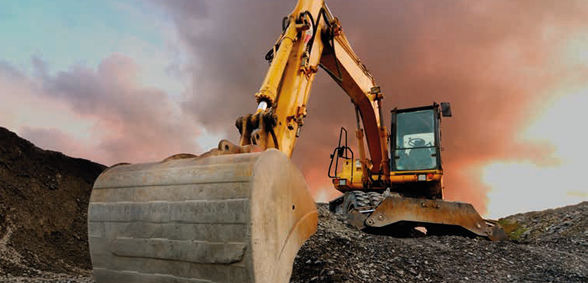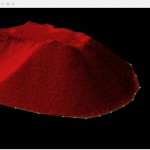Putting Stock in Your Survey
How accurate is UAV surveying for determining stockpile volumes? Bernhard Draeyer and Christoph Strecha took up the challenge of comparing UAV imagery with lLIDAR scans to see how they matched up.P.
One of the first questions asked when considering using UAV surveying methods for measuring stockpile volumes is about expected accuracy. Though this looks a simple question at first sight, it is not trivial to answer. This is the reason why Pix4D set up a stockpile test case to compare UAV images with terrestrial LIDAR scan surveys. Our analysis was performed on different sites containing several gravel and sand stockpiles as well as roads and some farmland with sparse vegetation. The site used for the comparison contains a sparsely vegetated earth protection dam against rockfall, several gravel stock-piles and an asphalt road. Flights were performed with senseFly fixed wing UAVs equipped with 16MP consumer grade Canon Ixus cameras.
For the comparison with terrestrial LiDAR, flights were conducted at an altitude of 120-140m above ground, achieving a GSD of 5cm. A total of 212 images with an overlap of 93 per cent were acquired. For the LIDAR survey, a Riegl VZ400 laser scanner was used, with two survey stations that were georeferenced using GNSS survey points. With this type of scanner and at a scanning distance up to several hundred metres, the relative point accuracy is generally expected to be at or below 5mm.
To measure the photogrammetric ground control points (GCPs) and terrestrial verification points, a surveyor-grade, dual-frequency RTK GNSS receiver was used, attaining elevation precision of 3-5cm. In total, some 500 ground points were sampled.
How to determine stockpile volumes?
Stockpile volumes can be determined using different methods. The traditional approach is to survey characteristic breaklines or use planimetry, where the volume is calculated by interpolating and summing up cross sections or profiles along an axis. However, with today’s simple and rapid to use GNSS receivers, terrestrial laser scanners and the newly introduced close range aerial photogrammetry, the tendency is to cover the stock-pile surface with a dense point network instead of simple cross-sections or a few breaklines. Powerful tools in standard GIS and CAD software then allow for very precise volume calculations by subtracting the surveyed surface from a former existing surface or a virtual reference plane. A third and still very popular method is to assume a bulking factor for a given material, then multiply it by the number of dumper transports. This method only applies where the mass movements can be followed strictly. Our study focused mainly on volumetric analysis by subtracting surfaces.
How did we test the datasets?
It is not easy to determine volume accuracy as it is mostly expressed as a percentage error margin. It is equally impossible to generalise it for differential surface volumetric calculations, mainly because the volume accuracy depends on not only the accuracy of the stockpile surface but also its height or thickness. Figure 1 illustrates this principle. As can be seen, the volume accuracy of a 10m-high stockpile is less sensitive to surface errors than a 3m-thin landfill.
We therefore concentrated on the accuracy of stockpile surfaces and generally used the Pix4D output surface as reference plane. This plane originates from a dense point cloud, which was filtered and sampled to a DSM grid at 5cm resolution. The processing settings within Pix4D software were left to standard values, in order to get a neutral, repeatable result. We compared the elevation values with an area of that was scanned with a LIDAR device. Most of the LIDAR scan sector was selected because it could be easily identified from about 10,000m2 both the air and the ground and possessed no or little vegetation.
The results
The histogram in Figure 2 shows a statistical analysis of the elevation differences between the DSM produced by Pix4D and the surface scanned with LIDAR. A positive value indicates that the Pix4D surface is higher than the LIDAR surface and vice versa. Some 2.7m points were compared. The mean deviation between the Pix4D surface and the LIDAR surface is about 3cm. Two-thirds of the test points lie within two times the GSD and three-quarters of the test points are within three times the GSD, reaching the same level as best possible results theoretically achievable with any photogrammetry method, even when using lower quality UAV imagery. While for the considered application such an error is marginal, more precise results can be obtained using either a higher quality camera or by reducing the flight altitude.
For the volume comparison, we designated several small-scale stockpiles to calculate their volumes. Using standard GIS software, the calculation was performed by subtracting the actual stockpile surfaces from a theoretical reference plane at the base of the stockpiles. The GNSS points were used to build a triangular irregular network (TIN) surface while the initially created 5cm DSM grids were used for the UAV photogrammetry and LIDAR data. A summary of the results is shown in Table 1.
It’s striking, how close the photogrammetry and LIDAR based volumes match. The GNSS-based volumes lie within just a few per cent as well. This difference is mainly due to the relative simple TIN that could be gained out of breaklines and single points from the terrestrial survey.
Conclusion
With UAV photogrammetry, volume calculation based on the method of surface diff erence is achieved with the accuracy needed to comply with practical surveyor requirements. The overall mean elevation of these surfaces only deviate centimetres from the ‘true’ surface. This is mainly achieved through the high resolution of the surface models, despite the fact that the single point elevations actually show a variation/noise of up to three times the GSD. For the considered application, such an error is marginal but, if required, surveyors can obtain more precise results using either a more adapted camera or by reducing the flight altitude.
While traditional surveying methods are still an interesting alternative for small surfaces, UAV photogrammetry is unmatched in terms of efficiency for surfaces above several hectares all the while producing equivalent accuracy. In addition, using the UAV surveying method not only produces a DSM but also a geo-referenced, highly detailed orthophoto – an important added-value for stockpile site documentation.
UAV photogrammetry is unmatched in terms of efficiency for surfaces above several hectares all the while producing equivalent accuracy.
Download the Full article here.




